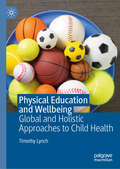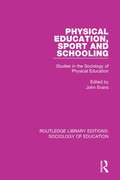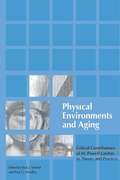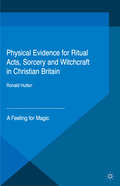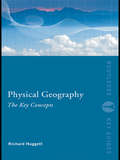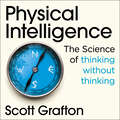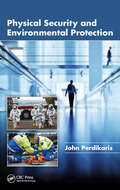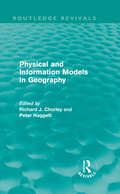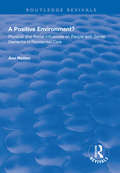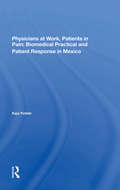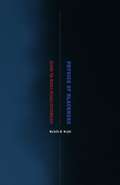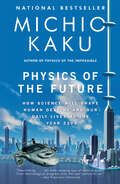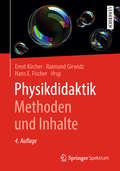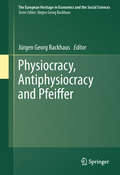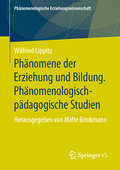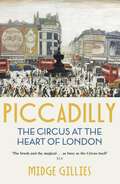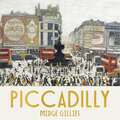- Table View
- List View
Physical Education and Physical Culture in South Africa, 1837-1966 (Palgrave Studies in Sport and Politics)
by Francois Johannes CleophasThe interconnectedness between sport and colonialism has long been a matter of interest to sport historians. Consequently, a large number of scholarly works exist on physical education and physical culture history, but there is no significant work on this within a South African context, both nationally and at community level. This book therefore provides the first historical account of physical education and physical culture in Cape Town, South Africa and its surrounding areas in the Western Cape.
Physical Education and Wellbeing: Global and Holistic Approaches to Child Health
by Timothy LynchThis book explores how physical education (PE) can be best enacted in primary schools in order to optimise children’s wellbeing. Drawing together extensive data from school communities around the globe, the author examines multiple dimensions of child health in practice. Ultimately, the findings suggest that PE is imperative within the wider landscape of children’s holistic learning, offering a powerful platform for meaningful connections across learning areas. While quantitative research has long evidenced the benefits of physical activity, this book contributes to the complex and global issue of what effective health and wellbeing approaches look like in practice. It is natural for children to enjoy movement for the purposes of play, exploration, learning and development: this book is essential reading for educators looking to enhance children’s wellbeing and general health.
Physical Education, Sport and Schooling: Studies in the Sociology of Physical Education (Routledge Library Editions: Sociology of Education #20)
by John EvansIn Britain the physical education curriculum has been experiencing a period of unrest. For many teachers the practices of decades have become problematic features of their curriculum and teaching. This book, first published in 1986, explores the experiences of teachers and pupils in programmes of physical education from a sociological perspective. In explores a range of issues relating to the organisation and management of physical education departments, deviancy and dissent in sport, gender inequalities and the concepts of community education and leisure education. This title will be of interest to students of sociology and education.
Physical Environments and Aging: Critical Contributions of M. Powell Lawton to Theory and Practice
by Paul Windley Rick ScheidtA tribute and guide to M. Powell Lawton's groundbreaking work! Dr. M. Powell Lawton, who died in January 2001, was arguably the most significant thinker, researcher, and practitioner in environment-behavior studies within the field of gerontology. The authors of Physical Environments and Aging represent three generations of internationally recognized researchers whose lives and work were greatly influenced by both Lawton the professional and Lawton the man. This book presents their assessment of his contributions to environmental theory, purpose-built housing, community study, long-term care settings, and other related topics. Many of the contributors also share personal anecdotes that illustrate how Lawton's professional visions were shaped by his remarkable intellect and personality. Physical Environments and Aging examines many aspects of environmental gerontology, including: housing policy reform and home modification place therapy philosophic foundations of environment-aging studies the future of theory, practice, and policy in the field the role of neighborhoods More than just an homage, Physical Environments and Aging is also a practical guide to the field, offering you tractable theory, useful methods and measures, and functional research overviews in the realms of everyday experience of older adults.
Physical Evidence for Ritual Acts, Sorcery and Witchcraft in Christian Britain: A Feeling for Magic (Palgrave Historical Studies in Witchcraft and Magic)
by Ronald HuttonThis volume investigates the physical evidence for magic in medieval and modern Britain, including ritual mark, concealed objects, amulets, and magical equipment. The contributors are the current experts in each area of the subject, and show between them how ample the evidence is and how important it is for an understanding of history.
Physical Geography: The Key Concepts (Routledge Key Guides)
by Richard John HuggettPhysical Geography: The Key Concepts is a thought-provoking and up-to-date introduction to the central ideas and debates within the field. It provides extended definitions of terms that are fundamental to physical geography and its many branches, covering topics such as: biogeography ecology climatology meteorology geomorphology hydrology pedology Complete with informative tables, diagrams, and suggestions for further reading, this is a highly accessible guide for those studying physical geography and related courses.
Physical Intelligence: The Science of Thinking Without Thinking
by Scott Grafton'An instant classic' Michael S. Gazzaniga, author of The Consciousness InstinctHow do you pick the right moment to cross a busy road?Or decide if you can drive through a storm? What helps you discover a shortcut to a familiar route?The answer is PHYSICAL INTELLIGENCE.Renowned neuroscientist, doctor and keen climber Scott Grafton draws on the very latest research, experiences with patients and his own dangerous hikes in the wilderness to explore the hidden depths of this silent intellect we all possess.Physical Intelligence explains the science behind our oldest ability and takes a fascinating and vital look at how we could and should use it better.
Physical Intelligence: The Science of Thinking Without Thinking
by Scott GraftonWhat is it that stops us from walking into walls or off cliffs? How do you pick the right moment to cross a busy road Or decide if you can drive through a storm? What helps you discover a shortcut to a familiar route?The answer is PHYSICAL INTELLIGENCESometimes, you need to do it to know it. Your hands have to be on the steering wheel to learn the feel of slipping tyres. You need to be watching the traffic to judge the best moment to cross the road. Everything we do, from changing a lightbulb to navigating unknown terrain relies on physical intelligence, our oldest and most important form of cognition. Physical intelligence was the key development in human evolution; thinking evolved first and foremost so we could do things. It has been the key to our survival against all the odds for so long that it has become instinctive, and continues to underpin our every action, from the ordinary (walking down a street) to the extraordinary (winning a race) and beyond. Renowned neuroscientist, doctor and keen climber, Scott Grafton was fascinated to discover how physical intelligence's most important components were laid bare, away from civilisation. In this book he takes you on a journey to explore the hidden depths of this silent, ruthless intellect we all possess. Drawing on the latest scientific discoveries and research, experiences with patients, and Professor Grafton's own gripping stories of survival in the wilderness, Physical Intelligence explains the science behind our most overlooked ability and takes a fascinating and vital look at how we could and should use it better. (P)2020 Hodder & Stoughton Limited
Physical Security and Environmental Protection
by John PerdikarisManage a Hazard or Threat Effectively and Prevent It from Becoming a DisasterWhen disaster strikes, it can present challenges to those caught off guard, leaving them to cope with the fallout. Adopting a risk management approach to addressing threats, vulnerability, and risk assessments is critical to those on the frontline. Developed with first res
Physical and Information Models in Geography (Routledge Revivals)
by Richard J. Chorley Peter HaggettFirst published in 1967, this book explores the theme of geographical generalization, or model building. It is composed of eight of the chapters from the original Models in Geography, published in 1967. The first chapter broadly outlines geographical generalization and examines the nature and function of generalized statements, ranging from conceptual models to scale models, in a geographical context. The following chapter deals with model theory in a wider scientific framework and the rest of the book discusses models of physical systems and information models. The book considers model-type generalizations that are applied in the three fields of geomorphology, meteorology and climatology, and hydrology before focusing on the transference of information and ideas in geography. This text represents a robustly anti-idiographic statement of modern work in one of the major branches of geography.
Physical and Social Influences on People with Senile Dementia in Residential Care: Physical and Social Influences on People with Senile Dementia in Residential Care (Routledge Revivals)
by Ann NettenPublished in 1993. The Increasing numbers of very elderly people in the population and the decreased use of long-stay hospitals are leading to pressure for services in the community for people with dementia. Residential care plays an important role in the care of such people, and developing new, innovative services and monitoring the quality of care in existing institutions are important policy issues. The book describes an investigation into the relationship between the residential care environment and the welfare of residents with senile dementia. Unlike many studies of residential care, the study included aspects of both the physical and social environment and examined the impact on residents over time. The study used some innovative approaches to assessing the impact of the environment of residents and the book describes a model using quantitative techniques to analyse outcomes for residents. The policy issues and provide pointers for specifying standards for the care of residents with senile dementia. The potential for innovative schemes building on the results of the study is discussed, and the concept of ‘informal care homes’ is introduced.
Physical and Symbolic Borders and Boundaries and How They Unfold in Space: An Inquiry on Making, Unmaking and Remaking Borders and Boundaries Across the World
by Basak Tanulku Simone PekelsmaThis book critically examines how borders and boundaries, physical and symbolic, unfold in different geographies and spaces. It aims to understand why they exist and how they are constructed, deconstructed, and reconstructed.The book explores why certain borders/boundaries persist while others are removed, and new ones are erected. It does not focus on one form of border, boundary or geographic location. It shifts its attention to different geographies, borders, and boundaries. It also focuses on intersections between them and how they complete each other. The book provides case studies from the past and present, allowing readers to connect subjects, periods, and geographies. The chapters address classical subjects such as nation-states and tackle novel questions such as ownership against access, that is, of urban infrastructures, COVID-19 and lockdowns, and the divides within digital worlds. The book benefits from visual essays that complement the theoretical and empirical chapters, showing the complexity of the phenomenon in a simple and effective way.The book will be of interest to academics, researchers, and students working in the fields of urban and rural studies, urban sociology, cities and communities, urban and regional planning, urban anthropology, political sciences and migration studies, human geography, cultural geography, urban anthropology, and visual arts.
Physician-Assisted Death in Perspective
by Stuart J. Youngner Gerrit K. KimsmaThis book is the first comprehensive report and analysis of the Dutch euthanasia experience over the last three decades. In contrast to most books about euthanasia, which are written by authors from countries where the practice is illegal and therefore practised only secretly, this book analyzes empirical data and real-life clinical behavior. Its essays were written by the leading Dutch scholars and clinicians who shaped euthanasia policy and who have studied, evaluated and helped regulate it. Some of them have themselves practised euthanasia. The book will contribute to the world literature on physician-assisted death by providing a comprehensive examination of how euthanasia has been practised and how it has evolved in one specific national and cultural context. It will greatly advance the understanding of euthanasia among both advocates and opponents of the practice.
Physicians At Work, Patients In Pain: Biomedical Practice And Patient Response In Mexico
by Kaja FinklerThis ethnographic study offers a detailed picture of how modern biomedicine is altered when practised in a developing country. Addressing the question of therapeutic outcome, Dr Finkler examines various aspects of biomedicine that influence patient response. The doctor-patient relationship is seen as especially important. Physicians and patients sp
Physics 100 Ideas in 100 Words: A Whistle-stop Tour of Science's Key Concepts
by DKGet to grips with the essential topics in physics today through 100 key ideas, each one explained clearly in 100 words.Physics: 100 Ideas in 100 Words offers the essential facts at your fingertips, satisfying your scientific curiosity and helping you to understand the biggest concepts in physics in concise, 100-word summaries. One of the first titles in a cutting-edge new series created in partnership with The Science Museum, this book introduces 100 key areas of physics such as gravity, motion, magnetism and quantum physics, and explains each topic in just 100 words. Perfect for getting your head around big ideas clearly and quickly, or refreshing your memory of the fundamentals of physics, this book covers the most up-to-date terms and theories and inspires a heightened level of understanding and enjoyment to the core areas of physics.
Physics of Blackness: Beyond the Middle Passage Epistemology
by Michelle M. WrightWhat does it mean to be Black? If Blackness is not biological in origin but socially and discursively constructed, does the meaning of Blackness change over time and space? In Physics of Blackness: Beyond the Middle Passage Epistemology, Michelle M. Wright argues that although we often explicitly define Blackness as a &“what,&” it in fact always operates as a &“when&” and a &“where.&” By putting lay discourses on spacetime from physics into conversation with works on identity from the African Diaspora, Physics of Blackness explores how Middle Passage epistemology subverts racist assumptions about Blackness, yet its linear structure inhibits the kind of inclusive epistemology of Blackness needed in the twenty-first century. Wright then engages with bodies frequently excluded from contemporary mainstream consideration: Black feminists, Black queers, recent Black African immigrants to the West, and Blacks whose histories may weave in and out of the Middle Passage epistemology but do not cohere to it. Physics of Blackness takes the reader on a journey both known and unfamiliar—from Isaac Newton&’s laws of motion and gravity to the contemporary politics of diasporic Blackness in the academy, from James Baldwin&’s postwar trope of the Eiffel Tower as the site for diasporic encounters to theoretical particle physics&’ theory of multiverses and superpositioning, to the almost erased lives of Black African women during World War II. Accessible in its style, global in its perspective, and rigorous in its logic, Physics of Blackness will change the way you look at Blackness.
Physics of the Future: How Science Will Shape Human Destiny and Our Daily Lives by the Year 2100
by Michio KakuNATIONAL BESTSELLER • The renowned theoretical physicist and national bestselling author of The God Equation details the developments in computer technology, artificial intelligence, medicine, space travel, and more, that are poised to happen over the next century. &“Mind-bending…. [An] alternately fascinating and frightening book.&” —San Francisco ChronicleSpace elevators. Internet-enabled contact lenses. Cars that fly by floating on magnetic fields. This is the stuff of science fiction—it&’s also daily life in the year 2100.Renowned theoretical physicist Michio Kaku considers how these inventions will affect the world economy, addressing the key questions: Who will have jobs? Which nations will prosper? Kaku interviews three hundred of the world&’s top scientists—working in their labs on astonishing prototypes. He also takes into account the rigorous scientific principles that regulate how quickly, how safely, and how far technologies can advance. In Physics of the Future, Kaku forecasts a century of earthshaking advances in technology that could make even the last centuries&’ leaps and bounds seem insignificant.
Physics, Nature and Society
by Joaquín MarroThis wide-ranging and accessible book serves as a fascinating guide to the strategies and concepts that help us understand the boundaries between physics, on the one hand, and sociology, economics, and biology on the other. From cooperation and criticality to flock dynamics and fractals, the author addresses many of the topics belonging to the broad theme of complexity. He chooses excellent examples (requiring no prior mathematical knowledge) to illuminate these ideas and their implications. The lively style and clear description of the relevant models will appeal both to novices and those with an existing knowledge of the field.
Physikdidaktik | Methoden und Inhalte
by Ernst Kircher Raimund Girwidz Hans E. FischerDas vorliegende Buch bietet den Leserinnen und Lesern einen fundierten Überblick über die Methoden der Physikdidaktik und bietet eine Hilfestellung, hochspannende Themen in den Physikunterricht einzubinden. In Einzelbeiträgen diskutieren Autorinnen und Autoren Methoden und Inhalte der Physikdidaktik – angefangen von der qualitativen Forschung in der Fachdidaktik über Aus- und Fortbildungen von Physiklehrerinnen und -lehrern zur Professionskompetenz und Nature of Science. Daran anschließend werden aktuelle und forschungsnahe Themengebiete und ihre mögliche Einbindung in den Unterricht dargestellt: Bio-, Quanten-, Nano- und Elementarteilchenphysik, Astronomie, Chaos, Physik des Klimawandels und die Physik der Gravitationswellen. Das Standardwerk Physikdidaktik wird in der Neuauflage thematisch getrennt angeboten: Grundlagen und Methoden und Inhalte. Beide Bände richten sich an Studierende des Lehramts Physik, angehende Lehrkräfte im Vorbereitungsdienst und Physiklehrerinnen und -lehrer.
Physiocracy, Antiphysiocracy and Pfeiffer
by Jürgen BackhausPhysiocracy, or the economic theory that a nation's wealth comes from is agricultural and land development, was a popular school of thought in France in the 18th century. The contribution and significance of the Physiocrats and Antiphysiocrats are explored in detail through chapter contributions by economists, philosophers, and social historians. The book concludes that neither the Physiocrats, nor the Antiphysiocrats were pure profit maximizers and that they all had the well-being of the commonwealth in mind. It brings to light previous studies only conducted in German and is the first analysis of Pfeiffer in a century, making the book of interest to any student or scholar of political economy and the history of economic thought. The contribution and significance of the Physiocrats and Antiphysiocrats are explored in detail through chapter contributions by economists, philosophers, and social historians. It brings to light previous studies only conducted in German and is the first analysis of Pfeiffer in a century, making the book of interest to any student or scholar of political economy and the history of economic thought.
Physiotherapy and the Elderly Patient (Routledge Library Editions: Aging)
by Davis Coakley Paul WagstaffOriginally published in 1988, the purpose of this book was to introduce the student and practicing physiotherapist to the multi-faceted components of the care and treatment of elderly patients and to present a problem-orientated approach to physiotherapy, assessment and management. Care of the elderly demands a dynamic and responsible approach and it was hoped that this book would improve therapy skills. The authors’ principle aim was to describe appropriate physiotherapy practice together with the pathology and medicine of old age. There is also consideration of social and psychological issues and working with the elderly people in the community as well as in hospital.
Phänomene der Erziehung und Bildung. Phänomenologisch-pädagogische Studien: Herausgegeben von Malte Brinkmann (Phänomenologische Erziehungswissenschaft #7)
by Wilfried LippitzDer Band versammelt historische und systematische Studien von Wilfried Lippitz der letzten Jahre zur Theorie, Geschichte und internationalen Verbreitung der Phänomenologischen Erziehungswissenschaft. Phänomene wie Sozialität, Leiblichkeit, Responsivität und Alterität werden systematisch reflektiert und pädagogische Grundbegriffe wie Lernen und Erziehen, Generation und Kindheit neu gerahmt. Neben historisch-systematischen und bildungsphilosophischen Studien bilden Texte unter der Fragestellung von Identität und Autobiographie das dritte zentrale Thema dieses Bandes. Er bietet einen übersichtlichen Einstieg in historische, internationale und aktuelle Diskurse der phänomenologischen Erziehungswissenschaft sowie in das Denken und Forschen von Wilfried Lippitz.
Piccadilly: The Circus at the Heart of London
by Midge GilliesThere's nowhere quite like Piccadilly Circus.From the moment they emerge, blinking from the underground station, visitors to Piccadilly Circus face a sensory onslaught. Its streets and alleyways merge into an intoxicating thoroughfare, with the power to propel an individual onwards to adventure, romance, or something more sinister. Ever since its iconic Eros statue appeared in 1893, the junction has been a vibrant meeting place, attracting visitors and pleasure-seekers from all walks of life: political plans and theatrical careers were hatched at its restaurant and café tables, lovers met below the statue of Eros, and to this day tourists pour out of its historic Tube to experience the bright lights of London's nightlife.Piccadilly explores how the area has been shaped by social and historical events - from female suffrage to world wars to technological advancements - and by its colourful cast of characters - from flower girls, shop assistants and sex workers, to film stars, Bright Young Things and conmen (and women).For many, the Circus has represented both a home from home and a brave new world, as campaigners, revellers, opportunists and romantics have all been drawn to Piccadilly's bright lights. This is the story of why Piccadilly Circus continues to mean so much to so many.
Piccadilly: The Circus at the Heart of London
by Midge GilliesA people's history of Piccadilly: London's bustling meeting place for over a century.There's nowhere quite like Piccadilly Circus.From the moment they emerge, blinking from the underground station, visitors to Piccadilly Circus face a sensory onslaught. Its streets and alleyways merge into an intoxicating thoroughfare, with the power to propel an individual onwards to adventure, romance, or something more sinister. Ever since its iconic Eros statue appeared in 1893, the junction has been a vibrant meeting place, attracting visitors and pleasure-seekers from all walks of life: political plans and theatrical careers were hatched at its restaurant and café tables, lovers met below the statue of Eros, and to this day tourists pour out of its historic Tube to experience the bright lights of London's nightlife.Piccadilly explores how the area has been shaped by social and historical events - from female suffrage to world wars to technological advancements - and by its colourful cast of characters - from flower girls, shop assistants and sex workers, to film stars, Bright Young Things and conmen (and women).For many, the Circus has represented both a home from home and a brave new world, as campaigners, revellers, opportunists and romantics have all been drawn to Piccadilly's bright lights. This is the story of why Piccadilly Circus continues to mean so much to so many.(P) 2022 Hodder & Stoughton Limited
Pick & Shovel Poet: The Journeys of Pascal D'Angelo
by Jim MurphyIn this inspiring biography, critically acclaimed author Jim Murphy tells the unique story of Pascal D'Angelo, who came to America in 1910 at the age of sixteen. Like so many immigrants from southern Italy and other parts of Europe, he took on the only job available to him, that of a manual laborer building roads and railways. Though his life was difficult, Pascal remained optimistic and never lost his sense of wonder at the world around him. He yearned for an outlet to express his passion, and so, remarkably, he taught himself English from newspapers and poetry books, in the process becoming a respected poet himself. Augmented with parallel references to other immigrant stories, this story of one man's life and noteworthy accomplishments is also a universal story shared by all American immigrants who helped build our nation. Source notes, bibliography, index.

